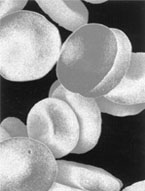Chaos and order...
 try bringing order to a child's cupboard. You will soon realise that it inevitably moves from an ordered state to a disorderly one. This tendency is by no means restricted to cupboards. We encounter it all the time around us - a broken cup of coffee, mixing of milk in tea - all these are examples of the Universe moving on a one-way street to disorder. But now, scientists have discovered a strange phenomenon whereby this same force of 'entropy' imposes order on a part of a system. Arjun Yodh and his colleagues at the University of Pennsylvania, usa, have discovered how an increase in entropy in one part of the system forces order on another. The discovery could have a profound impact on our understanding of cell biology (Physical Review Letters, Vol 80, No 2).
try bringing order to a child's cupboard. You will soon realise that it inevitably moves from an ordered state to a disorderly one. This tendency is by no means restricted to cupboards. We encounter it all the time around us - a broken cup of coffee, mixing of milk in tea - all these are examples of the Universe moving on a one-way street to disorder. But now, scientists have discovered a strange phenomenon whereby this same force of 'entropy' imposes order on a part of a system. Arjun Yodh and his colleagues at the University of Pennsylvania, usa, have discovered how an increase in entropy in one part of the system forces order on another. The discovery could have a profound impact on our understanding of cell biology (Physical Review Letters, Vol 80, No 2).
The concept of entropy was proposed in 1850 by the German physicist Rudolph Clausius, and is sometimes presented as the second law of thermodynamics. According to this law, entropy increases during an irreversible process such as the spontaneous mixing of hot and cold gases, the uncontrolled expansion of a gas into a vacuum and the combustion of a fuel. All spontaneous processes are irreversible. Hence, it has been said that the entropy of the Universe is increasing, that is, more and more energy becomes unavailable for conversion into mechanical work. Consequently, the Universe is said to be "running down". The idea that entropy could be associated with ordering was proposed in the late 1950s, but was largely unnoticed. In 1992, Yodh and his colleagues noticed that if large and small spheres of plastic were made to mix in a solution, the larger spheres pack themselves into structures around the container, leaving more space for the smaller spheres to be disorderly in the liquid. The whole process is uncoordinated and there is no contradiction with the law of thermodynamics as the total entropy of the system increases by such a process.
Now, Yodh and his team have shown that the same phenomenon is repeated in a tube with small and large spheres. The larger spheres move towards the edge of the tube and make room for the little ones. This could explain the mysterious process by which a red blood cell loses its nucleus. This happens when the cell dies and the haemoglobin inside it is recycled. The haemoglobin could be playing the role of the smaller spheres, pushing the nucleus out.
Engineers are also excited by the discovery as they feel it could be used to develop crystals that reflect light at all angles. This would be of great use in fibre optics communications and lasers.
Related Content
- Order of the National Green Tribunal regarding pollution at Rohtang Pass, Himachal Pradesh, 06/07/2015
- Central Motor Vehicles (Sixteenth Amendment) Rules, 2014 gives the way to e-rickshaws
- HC order has brought chaos in the path of legal mining: Goa Foundation
- Toll is back on Gurgaon e-way, so is mega jam
- Inter-departmental chaos still on as GSPCB and Directorate of Mines pass the buck on implementation of suspension orders to erring mines
- Understanding and predicting the Indian summer monsoon
